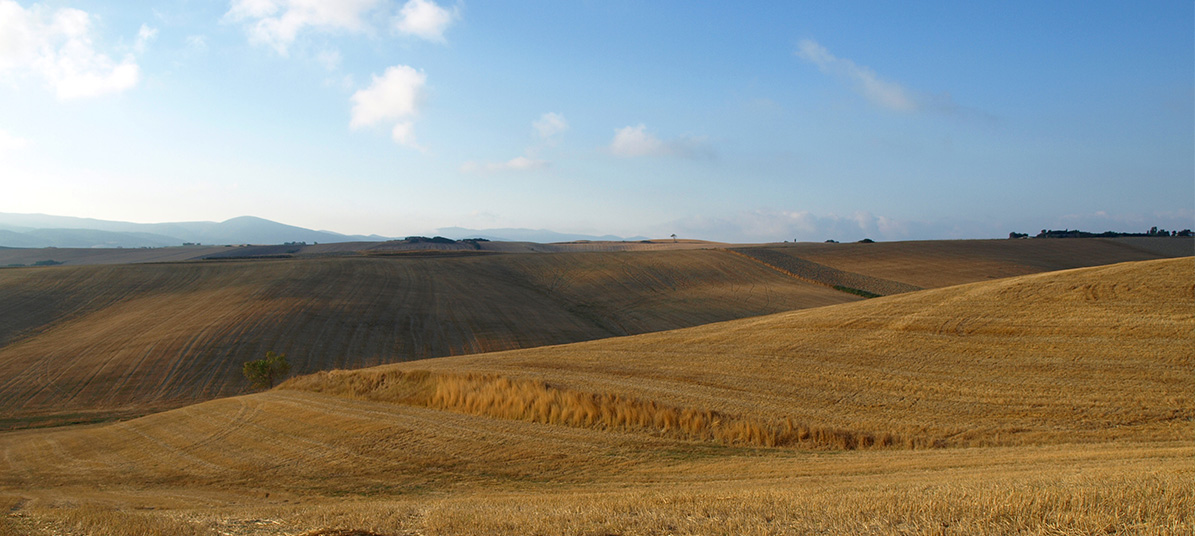| |
|
 |

|
 
 |
|
Southern Tuscany is an undiscovered jewel. Just south of Siena is the intriguing and distinctive semi-desert landscape of the Crete, which break up the enchanting green landscape of this part of Tuscany. The Crete are geographical features of clay, harsh and wild, difficult to cultivate by anyone who is not an expert and who doesn't respect the laws of nature.
The Crete Senesi contains all of those things which we have come to associate with Tuscany: a landscape of gently undulating hills, lined with cypress trees and covered by a patchwork of fields, olive groves and vineyards.
The Crete Senesi is home to some of the most remote vestiges of the Sienese heritage, with its towers and castles reaching toward the sky and its enchanting landscape in the Val d'Orcia. Driving from Siena to Montalcino, the capital of Brunello wines, the views are unforgettable and stops at the Sacred Art Museum at Asciano and the stunning Abbey of Monteoliveto Maggiore are absolute musts.
The atmospheric complex of the Abbazia di Monte Oliveto Maggiore, which was founded in 1313 by Giovanni Tolomei; surrounded by centuries-old cypresses, it dominates the landscape of the Crete. Besides the many works of art there, the abbey also has a library of forty thousand antique books, testimony to the cultural and artistic importance of the abbey between the 15th and the 16th century.
The communal territory of Castelnuovo Berardenga consists of many prestigious villas, built by aristocrats from nearby Siena. Villa di Geggiano, an Italian National Heritage Site south of Siena in the Chianti wine country, was built in the 14th century and was completely renovated in 1780. Its gardens feature sculpted boxwood hedges, hundreds of potted lemon trees, statues, topiary and an open-air theater used for classical music concerts.
|
|
|
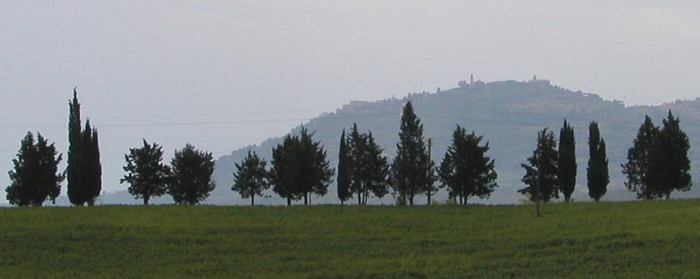 |
|
|
|
|
Montalcino, surroundings
|
| |
|
The Val d'Orcia and the Crete Senesi
|
|
|
The quiet Tuscan village of Montalcino has undergone few changes since medieval times, when it was a stronghold pertaining to the nearby city of Siena.
In addition to its sleepy medieval streets and sun-soaked vineyards, Montalcino presents other sights such as the Piazza del Popolo (People's Square) and the Palazzo dei Priori (old Town Hall), as well as the medieval churches of San Francesco, San Egidio and San Agostino. The castle of Montalcino (fortezza) with its two interior courtyards is almost perfectly preserved. The Cathedral (of San Salvatore) and the Diocesano Museum are full of sacred works of art by 11th to 16th century painters, and contain other medieval objects and archeological artifacts from San Antimo Abbey.
Everything revolves around wine production in Montalcino; the town is chock-full of intimate wine bars and shops selling the local vintages one of the finest and most renowned wines in the world, Brunello di Montalcino.
Podere Santa Pia is a good starting point for excursions to Montalcino and the nearby Abbazia di San Antimo, the villages in the Val d'Orcia, the Abbazia di Monte Oliveto Maggiore...
Montalcino was once a strategic point along the road to Rome and offers a panoramic view of the beautiful Asso, Orcia and Ombrone valleys.

|
|
 Montalcino, Piazza del Popolo Montalcino, Piazza del Popolo
|
| |
|
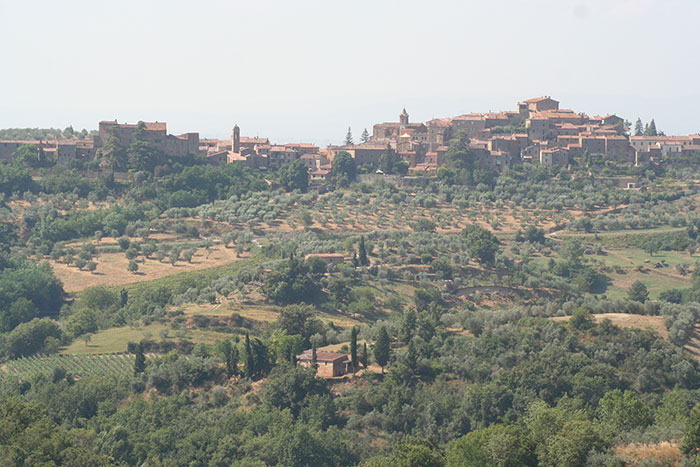 |
|
|
Castelmuzio
|
|
|
|
|
|
|
|
|
|
|
|
|
Castelmuzio, is part of the commune Trequanda under the province of Siena. This ancient village dates back to the time of the Etruscans, and is built on a volcanic limestone hilltop overlooking an amazing landscape. Over the years it has been called by several names, Castel Mozzo and later Castello. You can see the old city walls and ramparts, including the embrasures through which cannons were fired. The village includes three churches. The most famous is the Pieve di Santo Stefano in Cennano, just outside the village.
Sant' Anna in Camprena, is an ancient convent between Pienza and Castelmuzio where parts of The English Patient were filmed. The monastery contains remarkable frescoes by Sodoma.
Trequanda stands on the top of a hill, deep in unspoilt countryside of woods, vineyards and olive groves. This former medieval hamlet wasresidence of the Cacciaconti family until the 1500s. A third of the village is taken up by the castle Cacciaconti and its various annexes including a small ornamental garden. The majestic stone tower, partly rebuilt after the war, dominates the entire complex from the north-east and is a singular witness to the original fortified castle structure. From the airy town square where stand the castle, town hall and the splendid romanic church of SS. Pietro and Andrea church of SS. Pietro and Andrea (which contains a fresco by Sodoma), steep and narrow roads and alleys descend where the attentive visitor will be surprised to find ancient covered passages, small votive ceramics, family crests, and beautiful benches in travertine and tufa.
Cultural events
Second Sunday in May: Popular Festival of the Blessed Bonizzella
The remains of the Blessed Bonizzella are inside the Parish church of. SS.Pietro e Andrea. The village celebrates in May of each year the blessed, with a procession through the streets of the country, for the occasion covered with flower petals in May and rose.
East of Trequanda you reach Sinalunga. Among the most interesting monuments to see in Sinalunga we point out here the Collegiata di San Martino (Saint Martin Collegiate Church), the Chiesa di Santa Croce (Saint Cross Church), the Chiesa di Santa Lucia (Saint Lucy Church), the Pieve di San Pietro ad Mensulas (Saint Peter ad Mensulas Parish), the Chiesa di San Bernardino (Saint Bernardine Church), the Palazzo Pretorio (Praetorian Palace), the Teatro Ciro Pinsuti(Ciro Pinsuti Theatre) and the Antiquarium.
|
|
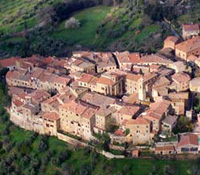
Castelmuzio

Sant’Anna in Camprena,
frescoes by Sodoma
|
| Abbazia di Monte Oliveto Maggiore |
|
One of the most breathtaking sights in Asciano is the Abbazia di Monte Oliveto Maggiore. It is located on a hilltop, immersed in a dark yet beautiful natural landscape, and is marked by a suggestive, mystical history. The abbey's origins date back to the middle ages. The interior of the abbey, renovated in Baroque style, houses a number of precious works of art, including an engraved wooden choir. In the magnificent rectangular Chiostro Grande, constructed between 1426 and 1443, note frescoes by Signorelli andSodoma. The monastery also houses a very rich library and an ancient pharmacy.
Leaving Monte Oliveto Maggiore and passing through San Giovanni d'Asso the route comes to Trequanda. A perfectly preserved 13th-century castle dominates the few houses that there are with its cylindrical crenellated tower. The church in the main Square, dedicated to Saints Peter and Andrew, is also 13th century and has a unique black and white stone checkerboard facade. Inside, there is a wonderful fresco of the Transfiguration by Sodoma.
At Taverne d'Arbia take the particularly scenic state road 438, toward Asciano.
|
|
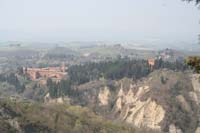
Abbazia di Monte Oliveto Maggiore |
| San Giovanni d'Asso |
|
The road from Montalcino to Radicofani runs through San Giovanni d’Asso, a small hamlet nestled comfortably in the hills of this beautiful landscape.
The ancient romanesque church of San Giovanni Battista is near to the castle, while in the lower part of the village lies the most important church in the area, the beautiful San Pietro in Villore, built in the 11th and 12th centuries, and which is now surrounded by many cypresses.
Among the numerous celebrations periodically taking place in San Giovanni d'Asso we remind the "Exhibit of the White Truffle" held yearly on November, during which it is possible to admire the famous typical white truffles.
Il Bosco della Ragnaia, on the outskirts of San Giovanni d’Asso, is a modern garden created by artist and philosopher Sheppard Craige that includes elements of formal spaces, modern art, and boschi (wooded areas).
|
|
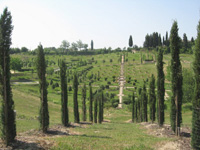 |
Asciano
Buonconvento |
|
The little town of Asciano lies in the foothills of the Crete, in the upper valley of the Ombrone river between Siena and the Valdichiana. Asciano is a typical medieval borough, surrounded by 14th century walls.
The Museo d'Arte Sacra, near the Romanesque parish church Collegiata di Sant'Agata, collecting 14th and 15th century works of painters and sculptors of Siena, among them by Matteo di Giovanni, Ambrogio Lorenzetti and the Osservanza Maestro.
The Musea Civico Areheologico, in the Chiesa San Bernardino, contains finds from the excavation of chamber tombs from the cemetery of Poggio Pinci.
The region is known for its production of white truffles, and hosts a festival, the Festival Accademia delle Crete Senesi, founded by Philippe Herreweghe.
The festival of Marzuolo Truffles takes place at San Giovanni d’Asso and attracts thousands of enthusiastic lovers of the delicious Marzuolo Truffle.
Buonconvento is an ancient settlement south of Siena, along the Via Cassia, where the Arbia and Ombrone rivers meet in the heart of the magical hills ofAmong the most important monuments to see in Buonconvento we point out here the Parrocchiale di San Pietro,, the Oratorio di San Sebastiano, the Palazzo Ricci (Ricci Palace), hosting today the Holy Art Museum of the valley of Arbia.
The important art works by Sienese artists such as Duccio di Boninsegna, Sano di Pietro, Andrea di Bartoio and Lucca di Tommè that were originally located in the Parrocchiale di San Pietro, are now in the Val d'Arbia Museum of Sacred Art, which is further down the Via Soccini, in the 19th-century Palazzo Ricci-Socini.
Inside the walls, the village is crossed from north to south by Via Soccini, the most aristocratic street in Buonconvento, with several palazzi. Palazzo Podestarile, with the 14th-century rectangular civic tower and the two Gothic arches in the façade, the Palazzo Comunale, or Town Hall, with its attractive brick front, and the imposing Palazzo Taja, built entirely in brick, and across from it is Palazzo Borghesi, built in the 14th century, which belonged to an old Sienese family whose coat of arms can be seen on the splendid façade.
In Murlo, Among the most important monuments to see in Murlo we point out here the Chiesa di San Fortunato (Saint Fortunato Church), the Palazzina (Residence) and the Palazzone (Big Palace, once Episcopal Palace) that today hosts the "Etruscan Antiquarium Museum of Poggio Civitate".
|
|
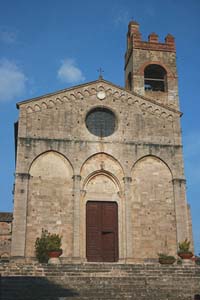 Asciano, Collegiata di Sant'Agata

Buonconvento
|
Monteroni d'Arbia
Grancia di Cuna
Lucignano |
|
Monteroni d'Arbia is an agricultural center, crossed by the Via Francigena, 17 km southeast of Siena.
As an agricultural production centre of the ancient Republic of Siena, it preserves the sign of its most important monument in the imposing medieval fortified mill from the beginning of the fourteenth century, of which the original structure is nearly intact, with its brick keep and mill-pond.
The pieve of St. John the Baptist, at Corsano, dates from before 1031. With a nave and two aisles, it is an example of Romanesque architecture with Pisan and Lombard influences. It houses two canvasses by Alessandro Casolari.
The church of Sts. James and Chrstopher, at Cuna, has remains of 14th century frescoes.
The splendid massive structure of Grancia di Cuna rises on the road from Siena, a beautiful example of a medieval fortified grain tower (13th century), originally belonging to the Hospital of Santa Maria della Scala which used it as a massive container for grain.
Comune
Lucignano is a fortified town, at 414 m. above the sea level, on the main route between Siena and Arezzo, overlooking Chiana valley. |
|
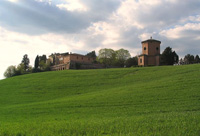
Monteroni d'Arbia
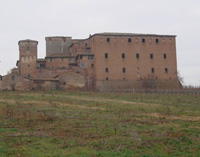
Grancia di Cuna
|
| Siena |
|
Built on three hills and surrounded by a magnificent territory, Siena is one of the most beautiful cities in the world. Recognized for the quality of its monuments, it has managed to conserve its essence and its mediaeval appearance.
Siena is the embodiment of a medieval city. Its inhabitants pursued their rivalry with Florence right into the area of urban planning. Throughout the centuries, they preserved their city's Gothic appearance, acquired between the 12th and 15th centuries. During this period the work of Duccio, the Lorenzetti brothers and Simone Martini was to influence the course of Italian and, more broadly, European art. The whole city of Siena, built around the Piazza del Campo, was devised as a work of art that blends into the surrounding landscape.
The Tuscan countryside around Siena is scattered with historical villas, real monuments the most important Tuscan families commissioned in the past as holiday residences, where to relax far from the chaotic city life.
|
|
|
| The Siena area |
|
The Tuscan countryside around Siena is scattered with historical villas, real monuments the most important Tuscan families commissioned in the past as holiday residences, where to relax far from the chaotic city life.
|
|
|
| |
|
The Chianti Region
|
|
|
| |
|
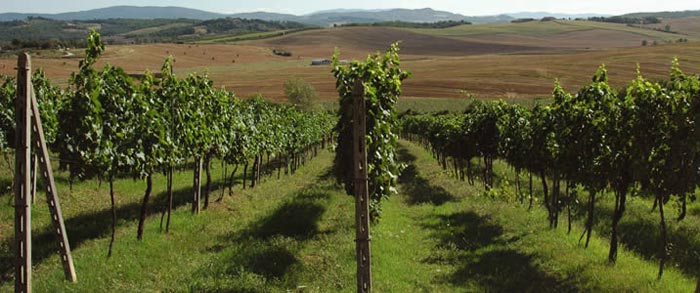 |
| |
|
|
| |
|
In the heart of Tuscany, between two large cities of art, Florence and Siena, lies the territory of the Chianti Classico.
The exquisite wine that is produced, known since the time of the Etruscans, has given prestige to the region and world-renowned.
|
|
|
| Castellina in Chianti |
|
Castellina in Chianti is part of the Chianti Hills, between the valleys of the Arbia, Pesa and Elsa rivers.
The first settlements in the area dates from the Etruscan age, and they were probably devastated by Gaulish invasions at the time of the latter's invasions against Rome.
In the early Middle Ages the town was known as Salingolpe; in the 11th century Matilda of Tuscany gave it as fief to the counts Guidi and, subsequently, to the Trebbio. In the early 15th century it became a strong fortress, of which today the Rocca remain.
The territory of Castellina in Chianti borders the municipalities of Barberino Val d'Elsa, Castelnuovo Berardenga, Greve in Chianti, Monteriggioni, Poggibonsi, Radda in Chianti and Tavarnelle Val di Pesa.
|
|
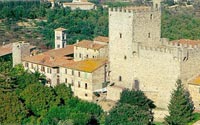 |
| Greve in Chianti |
|
Greve in Chianti is is located 42 km north of Siena. It is the principal town in the Chianti wine district which stretches south of Florence to just north of Siena. The old name was Greve. In 1972 Greve was renamed Greve in Chianti after the inclusion of that area in the Chianti wine district.
Sitting in the Val di Greve, it is named for the small, fast-flowing river that runs through it. Until recently it has been a quiet, almost bucolic town because it was, and still is, well off the main roads.
Even in ancient days Greve was not isolated because it was well-connected by secondary roads to the Via Volterrana and via Francigena. its tradesmen and farmers found ready markets for their goods and produce.
The Franciscan monastery is still at the heart of the old part of the city, as is the triangular main piazza, where a market has been running more or less continuously for centuries serving the nearby castle communities and hamlets.
The piazza is fronted by numerous medieval aged buildings, including the 11th century Chiesa Santa Croce which was rebuilt in 1325 after being burned to the ground, along with the rest of the town, by the Duke of Lucca, Castruccio Castracani. After further renovation, the church, which houses paintings of the school of Fra Angelico, now features a neo-classical facade. In the piazza there is also a monument to navigator Giovanni da Verrazzano, who was possibly born nearby, however more recent scholarly work places his birth at Lyon France.
The Pieve di San Cresci at Monteficalle is one of five mediaeval parish churches in the comune of Greve in Chianti.
Although the original Romanesque building has been altered in later times, the portico and the narthex are still preserved behind the facade with its central doorway flanked by two mullioned windows.
|
|
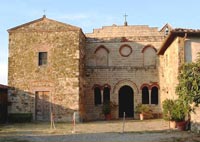 Pieve di San Cresci at Monteficalle |
|
|
The countryside around Gaiole is dotted with many castles due to the strong influence of the Firidolfi family, and later, by the Florentine Republic’s need for defensive positions. The surroundings of Gaiole in Chianti have several interesting place to visit: The Brolio Castle and the Meleto Castle,an half day tour can than be dovoted to visit the Castle of San Donato in Perano than Spaltenna,and Vertine, Badia a Coltibuono.
Badia a Coltibuono is located in the Chianti zone of Tuscany near the town of Gaiole in Chianti. This monastery, founded in 1051, was owned by the Vallumbrosan order of Benedictine monks until 1810. When Tuscany was under Napoleonic rule, the monks were forced to leave Coltibuono and the monastery was deconsecrated and bought by the Stucchi-Prinetti family. Badia a Coltibuono has been well-preserved and there are guided tours of the chapel and the italianate garden.
|
|
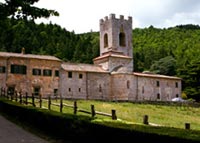 Badia a Coltibuono |
| Brolio Castle |
|
The castle of Brolio, situated in the center of the area of Chianti, is a very impressive castle. It preserves the ancient keep, the fortifications and the chapel. The wine cellar of the castle is famous all over the world for the celebrated wines of Brolio.
Its position was always strategical for the control of this area of Chianti, edge of the Florentine influence at the borders with the Sienese territory. The castle is on the road from Gaiole in Chianti to Montevarchi.
|
|
|
| Villa Vistarenni |
|
Villa Vistarenni is located between Radda and Gaiole in Chianti near Siena. It dates back to the 18th century and can look back to owners like the Strozzi princes or to the Sonnino barons.
Between the towns of Radda and Gaiole in Chianti, two key production centers in the history of Chianti Classico, there extends a large farm of approx. 500 acres, called Fattoria di Vistarenni. The 16th century Villa Vistarenni dominates it from a hilltop 500 m above sea level. The villa, a former property of the Florentine Strozzi Family, and later of the Sonnino Family, which gave birth to some senior officers of state in early Italian governments, now belongs to the Tognana Family. |
|
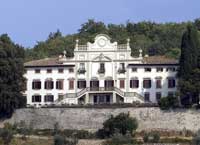
Villa Vistarenni
|
| Radda in Chianti |
|
Radda in Chianti is located up on a hill between the valleys of Arbia and Pesa. It has been inhabited since the 9th century and was already mentioned in a document from 1002.
Under Florentine control, Radda was the headquarters of the Chianti League and the seat of the Florentine governor housed in the beautiful 15th century Palazzo del Podestà, its facade decorated with several coats of arms. The town maintains its medieval look characterized by narrow streets meeting in the main square where you'll find the Church of San Niccolò, a church of Romanesque origins which displays a venerated wooden Crucifix from the 15th century.
Not far from this square is the Grand Duke's Ice house, built at the end of the 19th century to preserve snow and turn it into ice.
In the surroundings of Radda you'll find many castles and parish churches, such as the medieval Castle of Volpaia and the Romanesque Church of Santa Maria in Prato with beautiful flowered capitals in the Romanesque style.
Another landmark worth visiting near Radda is the Castello di Volpaia, of which records date back to the 12th. century. Its medieval structure remains intact.
|
|
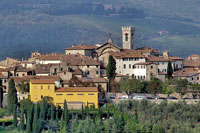
Radda in Chianti |
| |
|
Castello di Volpaia was once one of the powerfully castles in the community of Radda in Chianti. After Florence had taken in Siena, the castle lost its military function and extended itself into a peaceful hamlet. It’s one of the pearls of the Chianti region.
The origins of Castello d’Albola can be traced back to the 12th century.
The castle has belonged to some noble tuscan families along the years: the Acciaioli, the Samminiati and the Pazzi, as well as the first Counts of Ginori, all of which contributed to the development of Tuscan history.
From 16th century onwards Albola became one of the most highly desired estates among the families of Florence. This is demonstrated by the interest of the Samminiati who, at the beginning of the 17th century when the male line of the Acciaiuoli had become extinct, took possession of Pian d’Albola thanks to the marriage between Ascanio Samminiati and Caterina Acciaiuoli. It was another Ascanio Samminiati, in the middle of the 18th century, who turned Pian d’Albola into a luxurious residence. Ascanio Samminiati also gave a new thrust to viticulture, devising - for the first time – an overall plan for the estate, including impressive irrigation works.
When Samminiati died, the property one again passed through a marital alliance to the Pazzis, one of the most noble and ancient Florentine families, who in fact kept it until the middle of the 19th century.
For the next hundred years Pian d’Abola passed through several hands until 1940, when it was acquired by Prince Giovanni Ginori Conti. Forty years later it became the property of the Zonin Family, which initiated its second Renaissance.
|
|
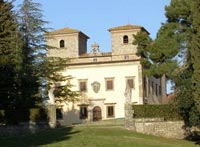
Villa Albola |
| Barberino Val d'Elsa |
|
The township of Barberino Val d'Elsa is located above the valley from which it takes its name. The centre of town is still ringed by its original fortifications.
The Piazza Barberi includes the Church of San Bartolomeo which houses a fragment of an annunciation by the school of Giotto (14th-15th century) and a bust in bronze by Pietro Tacca.
The Via Francesco da Barberino leads to the 14th century Porta Senese (Sienese Gate), and the Ospedale dei Pellegrini (Pilgrims' Hospice) dating from 1365.
The Church of Sant'Appiano was built during the 11th century (part in stone) and 12th century (part in brick) and now includes the Antiquarium Museum housing various Etruscan artefacts from the many necropoli in the area, the village of Linari, the Castle of Poppiano at Vico d'Elsa and Petrognano.
The Chapel of San Michele Arcangelo was built in 1597 by Santi di Tito as a perfect 1:8 scale reproduction of the Cupola of the Cathedral of Florence. It was constructed on the site of the ancient city of Semifonte, razed to the ground by the Florentines in 1202. The site remains a focus for archaeological study.
|
|
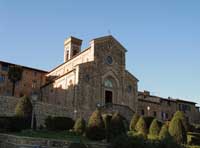
Barberino Val d'Elsa, Chiesa di San Bartolomeo |
|
|
Castelnuovo Berardenga has an interesting old clock tower and a relaxing ambience. However, the main reasons to visit Castelnuovo Berardenga lie more in the surrounding area, particularly the Certosa of Pontignano, the italianate gardens of Villa Chigi Saracini and Villa di Geggiano, the English garden of Villa di Monaciano, and villages such as San Gusmè.
Abbadia d'Ombrone and Monastero d'Ombrone near Castelnuovo Berardenga, is an ancient medieval stronghold, dating from the 11th century. The place name Monasterio refers to the nearby church of San Salvatore della Berardenga. Monastero dell’Ombrone was once the home of the noble Chigi Saracini family of Siena. On the villa's left side stands a Romanic imposing bell tower in Lombard style with a squared plan. At the opposite side there is the S. Salvatore Church.
|
|
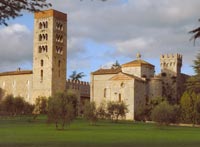
Monastero d'Ombrone
|
| |
|
The communal territory of Castelnuovo Berardenga consists of many prestigious villas, built by aristocrats from nearby Siena, examples include: Villa Chigi Saracini which is located at the entrance of Castelnuovo; its style led to a radical change in the country’s urban scheme, with the demolition of the boundary wall of the castle being replaced with a retaining wall. You may visit it’s beautiful Italian garden and English park.
Further villas are Villa di Geggiano ( Villa Bianchi Bandinelli) and Villa di Monaciano both famous for their splendid gardens.
Five kilometres from Siena near Castelnuovo Berardenga, on the top of a hill covered in vineyards, stands the Villa di Geggiano. The villa’s history starts in the 14th century, it was restored around the 18th century and has beautiful gardens and an open air theater.
Owned by the Bianchi Bandinelli family from the first half of the 16 C, was originally a much smaller lodge, which in 1768, was transformed into a grand villa with a garden and its own chapel on the occasion of the wedding of Anton Domenico Bianchi Bandinelli and Cecilia Chigi. A long tree-lined avenue characterized by cypresses and holm-oaks leads
all the way to the entrance gate, running parallel to the ‘Teatro di Verzura’, an outdoor theatre located on the southern side of the garden.
Andrea and Alessandro Boscu Bianchi Bandinelli are the current proprietors of the Villa di Geggiano, a national monument that has been in their family since 1527.
Villa di Geggiano was one of the locations for the film Stealing Beauty (1996, Bernardo Bertolucci), starring Liv Tyler and Rachel Weisz.
|
|
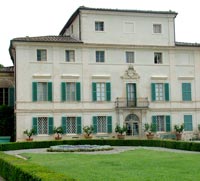
Villa di Geggiano |
| |
|
Villa Chigi Saracini, designed in the early 19th century by its owner Galgano
Saracini, stands at the entrance to the town of Castelnuovo Berardenga. The Villa, with its splendid gardens, has been built up on the initiative of Count
Galgano Saracini who wanted a great decorum house for his family, with a
large park to make the most of it. Building the new complex produced a
radical alteration of the main urban order, since a big part of
castle-walls was been pulled down. The complex (villa-chapel-park) has
been carried out between 1820 and 1840 and is partly attributed to
Agostino Fantasici. The way the park now looks like is due to Count
Guido Saracini, great music lover and founder of Chigiana Music
Accademy.
A small nymphaeum, semi-circular in shape, stands beneath the entrance forecourt, along the avenue leading to Sarrocchi's fountain, and is reached by a short flight of travertine steps. Another interesting feature of the park is its complex system of avenues and winding paths running up and down the hilly terrain.
|
|
 Villa Chigi Saracini
|
| |
|
Val di Merse
|
|
|
| Sovicille |
|
Sovicille is located about 10 km west of Siena on the old via Maremmana, the road running from Siena to the coast of the Maremma.
The territory of the comune of Sovicille is one of the largest of the 36 communes in the province of Siena and the greater part of it has remained intact for hundreds of years, The Montagnola hills reach 620 meters in height and are covered with forests made up of various oaks chestnuts hornbeams, cypresses, pines, junipers and many other bushes and scrubs that are typical of the Tuscan region.
The soil is made up of cavernous limestone formations along with a beautiful yellow-streaked marble called Broccatello. One can see only old farmhouses, tiny hamlets, villages, castles, medieval churches and ruins of archaic settlements that appear among the thick vegetation that changes color each season. This varied landscape attracts nature lovers, artists and photographers from all over the world.
The most populated hamlets of the commune are San Rocco a Pilli and Rosia where there are numerous commercial and artesian businesses. Many smaller and medieval villages and villas are nestled in the woods around Sovicille, each with their own special characteristic. Tonni, Borgo Pretale, Reniere, Radi, Molli, Tegoia, Recenza, Cerreto a Merse are some and one finds them immersed in the woods of the Montagnola. On the downward slopes, the villages of Simignano, Ancaiano, Personata and Piscialembita have remained intact, as well as the villa of Cetinale.
Caldana, Valacchio and Toiano with its impressive structure of the Palazzaccio castle, are located on the east side of Sovicille. These ancient settlements were Etruscan in origin. Nearby there is the ancient village of San Giusto that brings us back centuries. On the southern side of the territory the little villages of Ampugnano, Barontoli, Pilli, Brucciano, and Castello are worth mentioning as they are all well preserved. Other historic jewels are Brenna with its old mill and wool textile plant, Toni with its famous Cistercian cloister of unique beauty, and the beautiful 13th century residential towers of Stigliano. Along the green and suggestive road from Rosia to Massa Marittima an antique bridge appears like a vision from ancient times, the bridge of Santa Lucia, commonly called "Ponte dell Pia". There are also numerous medieval castles and palaces throughout the territory, Celsa, Palazzo al Piano, Capraia, Montarrenti, Spannocchia, Poggiarello, Palazzone, Villa di Cetinale, Villa di Toiano and Villa di Cavaglioni.
For the art lovers a visit to the romanesque churches shouldn't be missed as they are the most suggestive that one can imagine. These are San Giovanni Battista al Ponte allo Spino, San Giovanni Battista a Perlina, San Giusto in Balli, Santa Mustiola a Toni, San Magno a Simignano, San Giovanni Battista a Rosia and San Giovanni Battista a Molli.
Walking in Tuscany | Itinerarys in the surrounding hills of Sovicille
|
|
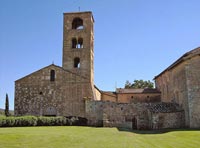
Parish Church Ponte allo Spino |
| Ponte della Pia (Pia's Bridge) |
|
Ponte della Pia (Pia's Bridge) is the most charming bridge of this area. In Etruscan times an ancient road crossed it, the bridge linked the Merse Valley to the Maremma Toscana. The bridge has probably Roman origins and it has been rebuilt during the Middle Ages in Romanic style. According to some legends, the beautiful Pia, Nello d'Inghiramo de' Pannocchieschi's sorrowful wife, crossed this bridge to go into exile in Maremma, at Castello della Pietra.
From this bridge, we know from the legend, the beautiful Pia (unhappy wife of Nello d'Inghiramo de Pannocchieschi) passed to go into exile in Maremma, in the Castle of the Stone. Of this Dante Alighieri spoke in the Fifth canto of Purgatory:
"Oh, when you will have come back into the world
And you will have rested from the long walk,
follow the third spirit, after the second,
remember me, I am Pia,
born in Siena and died in Maremma.
How I died, he, who first gave me his ring
And then married me, knows."
|
|
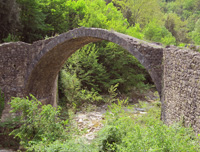
Il Ponte della Pia
|
Chiusdino
L'Abbazia di San Galgano |
|
The abbey of Saint Galgano, with the Montesiepi hermitage rise in the valley of the river Merse, between the medieval villages of Chiusdino and Monticiano. The site is made up of two major attractions: the gothic roofless cathedral (1224) and the unusually shaped monastery of Montesiepi, and ancient hermitage, which hosts the tomb of San Galgano and the sword in the stone.
The Abbey of San Galgano was built in the 13th century when the old chapel and monastery became too small for the pilgrims who visited the tomb of the saint from Siena. L'Abbazia di San Galgano was Tuscany's first pure Gothic church, and it was later used as the model for the Cathedral of Siena. |
|
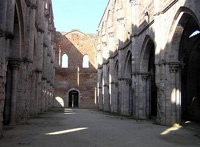
Abbey of San Galgano
|
| Monticiano |
|
Monticiano, a very old village which dates back to the 12th century, is located in a beautiful area, in the heart of a valley between the river Merse and the river Farma. The oldest part of the village is located on a hilltop, within the remains of the ancient walls. From the top of the hill the view over the valley of the river Merse is breathtaking.
The village has two churches, the Romanesque Chiesa di Sant'Agostino of the late 13th century, with baroque interiors andin the chapter room of the former monastery frescoes by Bartolo di Fredi, and the older parish Pieve dei Santi Giusto e Clemente, of the 12th century, with a neat stone façade.
Monticiano is only 5km away from the mysterious Abbey of San Galgano and the legendary sword in the stone. The village of Bagni di Petriolo with the thermal spas Terme di Petriolo belongs to the municipality of Monticiano.
|
|
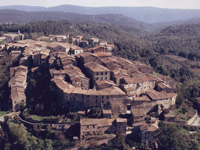
Monticiano |
| |
|
The Val d'Elsa
|
|
|
| |
|
 |
| |
|
Montereggioni
|
Monteriggioni
Abbadia a Isola |
|
Monteriggioni is perhaps one of the most evocative medieval villages in Italy, stuated 14 km from Siena. Sitting on a small natural hillock, the Monte Ala, this completely walled medieval town in the Siena Province of Tuscany was built in the 13th century.
The walls and towers are virtually intact, and the visual effect from a distance is quite astonishing.
The main piazza, the Piazza Roma, is dominated by a Romanesque church Santa Maria Assuntawith a simple, plain facade. Other houses, some in Renaissance style and once owned by local nobles, gentry and wealthy merchants, face into the piazza. Off the main piazza, smaller streets give way to public gardens fronted by the other houses and small businesses of the town. These public gardens fed the village when it was under siege.
Dante referred to Monteriggioni in the Divine Comedy: Inferno, xxxi. 41-44 '...come in su la cerchia londa Monteriggioni di torri si corona'.
Abbadia a Isola
Abbadia a Isola is located half way between Colle Val d'Elsa and Monteriggioni. On February 4, 1001, Ava, the widow of Ildebrando dei Lambardi of Staggia, founded a family Benedictine monastery dedicated to San Salvatore in the area of Borgonuovo, a halting place on the Via Francigena. Between 11th and 12th centuries the monastery was completed with walls, gateway and towers. In this period was also erected the Romanesque Abbey of St.Salvatore.The Abbey, built in the 11 C by the Cluniac Benedectines, has a façade decorated with miniature arches and the interior consists three aisles divided by columns alternated to cross-shaped pillars.
|
|
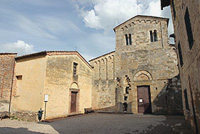
Abbadia Isola
|
| Colle di Val d'Elsa |
|
Locally referred to as Colle, Colle di Val d'Elsa is situated above the valley of the river Elsa. The Val d'Elsa which hosts towns like San Gimignano, Certaldo, Colle Val d'Elsa, Casole d'Elsa, Monteriggioni, Barberino Val d'Elsa and Poggibonsi.
The area of Colle was an important crossroads to and from central and northern Etruria.
Due to its strategic position along the way of Via Francigena, the medieval pilgrimage and trading route from Central Europe to Rome, Colle di Val d'Elsa developed in three different areas, each of them with its idiosyncratic architecture and art: Il Borgo di Santa Caterina, Il Castello di Piticciano and Il Piano. |
|
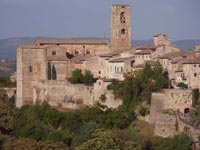
Colle di Val d'Elsa, Duomo
|
| Casole d'Elsa |
|
Casole d' Elsa is a village characterised mainly by its buildings of ancient brick, placed.
Colle di Val d'Elsa is located on the ridge of a hill in the heart of Tuscany, close to the cities of Siena, Florence and Volterra, along the route of the old Via Francigena, the medieval highway of long-haul pilgrims travelling to Rome from northern Europe.
Casole d' Elsa originally was developed in three distinct sites, Il Borgo of Santa Caterina, Il Castello di Piticciano, and Il Piano. La Rocca is the most important civil building in Casole, today the seat of the Town Hall.
Other important monuments to see in Casole d'Elsa we point out here the Collegiata di Santa Maria Assunta, the Canonica, the Chiesa di Santo Spirito, the Chiesa di San Pietro, the Chiesa di San Niccolò and the Palazzo Pretorio.
|
|
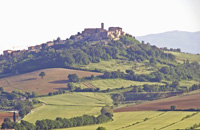
Casole d'Elsa
|
| San Gimignano |
|
San Gimignano is a small walled medieval hill town and is mainly famous for its medieval architecture, especially its towers. San Gimignano has managed to conserve fourteen towers of varying height which have become its international symbol.
There are many churches in the town: the two main ones are the Collegiata, formerly a cathedral, and Sant'Agostino, housing a wide representation of artworks from some of the main Italian renaissance artists.
The main streets are Via San Matteo and Via San Giovanni, which cross the city from north to south. The heart of the town contains the four squares, Piazza della Cisterna, Piazza Duomo where the Collegiata is located, Piazza Pecori, and Piazza delle Erbe.
The Communal Palace, once seat of the podestà, is currently home of the Town Gallery, with works by Pinturicchio, Benozzo Gozzoli, Filippino Lippi, Domenico di Michelino, Pier Francesco Fiorentino, and others. The town also is known for the white wine, Vernaccia di San Gimignano.
|
|

San Gimignano and its fourteen towers
|
| |
|
The itinerary from San Gimignano to Monterriggioni is one of the most beautiful legs of the Via Francigena. After the frst section of the path, you begin to walk up and down in the valley of the Foci river, near Molino d'Aiano.
This 29.8 km leg begins in San Gimignano and takes in about 7 hours to complete A path leads upward to the Romanesque church of Santa Maria a Coneo. Then you cross the bridge on the hilltop to reach the Romanesque church of San Martino di Strove. Then you go to the Abbey of Island, before catching a sight of Monteriggioni, with its unmistakable ring of walls and towers that dominate the surrounding hills.
Walking in Tuscany| From San Gimignano to Monteriggioni - 29,5 km
Other itineraries | Southern Tuscany | Montalcino, Siena, Socicille, San Gimignano and the Val d'Elsa |
|
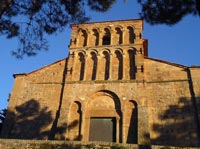
|
| |
|
|
|
|
| |
|
|
|
|
|
|
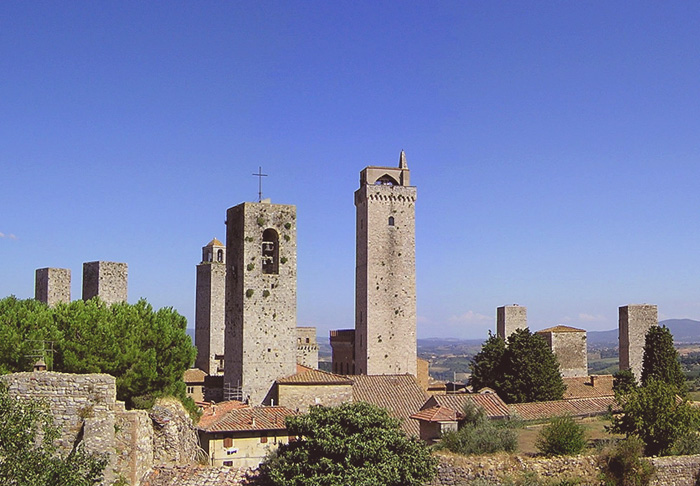 |
|
|
|
|
|
|
|
|
|
|
|
|
|
|
|
|
|
|

La Via Francigena | Da Ponte d'Arbia e Buonconvento a San Quirico d'Orcia
|
|
|
| |
|
View Crete Senesi in a larger map |
|
|
|
|
|
|
|
|
|
|
|
|
|

|
|
|
|
 |
|
| |
|
 |
|
|
|
 |
|
|
|
 |
|
|
|
 |
|
|

|
|
|
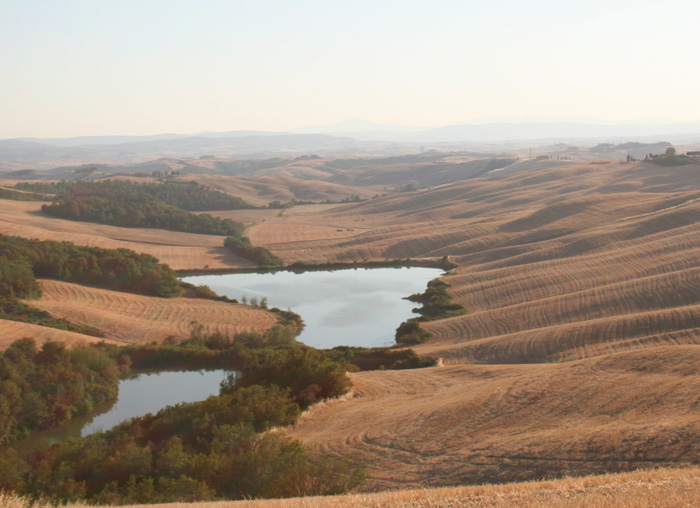 |
|
|
The Crete Senesi, stunning landscape between Siena and Asciano
|
| |
|

 |
| |
|
|
|
|
|
|
|
|
|
|
|
|
|
|
